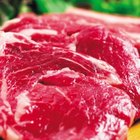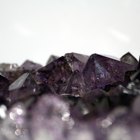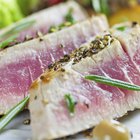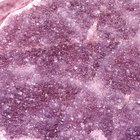
One of the food industry's fundamental truths is summed up in the phrase "people eat with their eyes." Foods that look good are simply more appealing than foods that don't. That's hardly a surprise, but it can be inconvenient for cooks. For example, deli customers might avoid sliced roast beef because it has rainbow-tinted highlights. That's completely natural, however, and usually unrelated to the meat's freshness.
Iridescence
To understand how these iridescent highlights happen, it's important to remember that beef and other meats aren't simple substances. They're made up of a staggering number of proteins, fats and mineral compounds, all with their own distinctive chemical properties. Light that passes through these substances is reflected and split, or refracted, in the process. Many of the muscle fibers contain iron-bearing compounds, which help make the beef red when it's uncooked. Since they absorb red hues from the refracted light, most of the shiny rainbow colors on the beef have a disconcertingly green tinge.
Contributing Factors
The rainbow effect is exaggerated by a couple of other factors. For one, meats that have been brined or cured are more likely to show iridescence. That's because they retain more moisture after curing, and therefore reflect more light. Roast beef isn't cured, but deli beef is often lightly brined for flavor and moisture retention. Second, perfect slicing -- and the smooth surface it produces -- accentuates the rainbow effect. You'll seldom see it at home, but in the deli with its high-speed slicers, it's common. Third, some meats are more prone to producing rainbows. The round roasts commonly used for sandwich beef have exactly the kind of densely packed muscle tissues most likely to create iridescence.
Other Meats
Several other cuts share that characteristic, and are just as likely to show rainbow hues. For example, beef from the navel and brisket cuts are frequently cured for sale as pickled or corned beef. Like the round, these cuts are sections of very dense muscles, and like deli roast beef, they are usually sliced very thin for sandwiches on a mechanical slicer. The effect can also sometimes be seen on thinly sliced hams, especially from denser muscles from the shank.
Real Spoilage
It's intuitively obvious that if your slice of "red" meat has turned green, it shouldn't be eaten. Like many other things that are intuitively obvious -- a flat earth springs to mind -- it's also wrong. Iridescent hues can occur even in the freshest of roast beef, so they're not a good indicator of spoilage. Discoloration from spoilage can cause green, gray and yellow hues, but color isn't your only clue. Spoilage will also create a thin, sticky bacterial layer over the meat, and it will have a clearly unpleasant odor and sour flavor. If your beef has green tints but smells fresh, isn't sticky to the touch and is within its freshness date, it should be perfectly safe.
Related Articles

What Causes Raw Steaks to Lose Red ...

How to Know If Roast Beef Looks Good or ...
The Differences Between Prime & Dry ...

What Happens if You Cook Steak a Day ...

Do Filet Mignon Steaks Come From Female ...

What Is a Black Forest Ham?

What Does Spoiled Meat Smell Like When ...

How to Know if Marinated Steak Is Bad

Why Do Pork Chops Turn White?

Different Kinds of Lunch Meat

Types of Valuable Crystals

How to Know if a Steak Is OK to Cook

Choice Vs. Prime Beef Grades

Which Cheeses Go With Honey Ham?

The Best Way to Cook Sirloin Steak ...

What Kind of Beer Is Good to Marinate ...

Tuna Steaks Nutrition

What Is a Pink Amethyst?

Can You Eat Hamburger Meat That Is ...

Is a Roast Bad If It Turns Brown?
References
- USDA Food Safety and Inspection Service: Beef From Farm to Table
- Ohio State University Meat Science: Iridescence in Raw and Cooked Meats
- On Food and Cooking: The Science and Lore of the Kitchen; Harold McGee
Writer Bio
Fred Decker is a trained chef and prolific freelance writer. In previous careers, he sold insurance and mutual funds, and was a longtime retailer. He was educated at Memorial University of Newfoundland and the Northern Alberta Institute of Technology. His articles have appeared on numerous home and garden sites including GoneOutdoors, TheNest and eHow.
Photo Credits
Jupiterimages/liquidlibrary/Getty Images